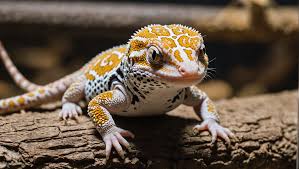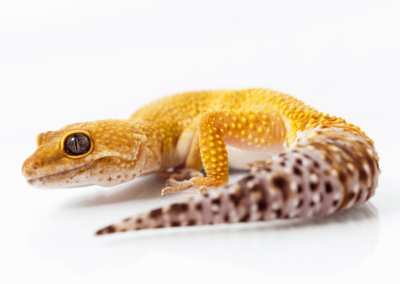Creating the ideal environment for your leopard gecko is crucial for their health and well-being. One of the most important aspects of setting up their habitat is ensuring the correct temperature range. So, what temperature should a leopard gecko tank be?
This article will walk you through the optimal temperature settings to help keep your leopard gecko active, healthy, and comfortable. From basking spots to cooler areas, we’ll cover everything you need to know to create a perfect home for your scaly friend.
Importance of proper temperature for their health and well-being

When it comes to keeping your leopard gecko happy and healthy, temperature is one of the most crucial factors to get right. As a reptile, your gecko depends on the environment to regulate its body heat, so setting up the right temperature in their tank isn’t just a detail—it’s essential.
From my experience, ensuring the right temperature range can make a huge difference. Leopard geckos need a warm spot for digestion. If it’s too cold, their digestive system can slow down, leading to issues like impaction, where they have trouble processing food. I’ve seen geckos with digestive troubles that could have been avoided with better temperature control.
Metabolic function is another biggie. Leopard geckos rely on heat to keep their metabolism running smoothly. When their habitat is too cold or too hot, you might notice changes in their appetite and energy levels. Keeping the temperature steady helps them stay active and alert, which is vital for their overall well-being.
A well-regulated temperature also supports a healthy immune system. I’ve found that when temperatures fluctuate too much, geckos are more prone to infections. On the flip side, a stable, optimal temperature helps them fend off illnesses and stay robust.
And let’s not forget about their behavior. Proper heating keeps them active and engaged. If the tank’s temperature isn’t right, you might see your gecko being lethargic or hiding more than usual, which can be a sign of discomfort.
For those breeding leopard geckos, temperature becomes even more critical. Successful egg development and incubation depend on maintaining the right conditions. I’ve seen breeding projects fail due to temperature issues that could have been easily managed with a good thermostat.
In short, getting the temperature right isn’t just about comfort—it’s about ensuring your leopard gecko thrives. By creating an environment that mimics their natural habitat, you’re helping them lead a happy and healthy life.
Ideal temp for leopard gecko
When setting up your leopard gecko’s habitat, getting the temperature just right is crucial for their health and happiness. Here’s a breakdown of the ideal temperature range to keep your scaly friend thriving:
- Warm Spot (Basking Area): Leopard geckos need a warm basking spot to help with digestion and overall metabolic function. Aim for a temperature of around 88-92°F (31-33°C). This area allows your gecko to warm up and digest their food properly.
- Cool End: On the other side of the tank, provide a cooler area where the temperature should range from 75-80°F (24-27°C). This cooler zone gives your gecko a place to retreat if they get too warm and helps them regulate their body temperature naturally.
- Nighttime Temperature: At night, it’s okay for the temperature to drop slightly. Aim for a range of 70-75°F (21-24°C). Leopard geckos can handle a drop in temperature, but it shouldn’t be too drastic.
- Temperature Gradient: Creating a temperature gradient within the tank is key. This means having a range of temperatures from the warm basking spot to the cooler end. This gradient allows your gecko to move to different areas depending on their needs, much like they would in their natural habitat.
- Monitoring: Use reliable thermometers to keep an eye on both the basking spot and the cooler end. Digital thermometers with probes can give you accurate readings and help you make adjustments if necessary.
Maintaining these temperature ranges will help ensure that your leopard gecko stays active, healthy, and comfortable. It mimics their natural environment and supports their vital bodily functions.
Measuring and Monitoring Temperature
Accurate temperature measurement and monitoring are crucial for maintaining a healthy environment for your leopard gecko. Here’s a practical guide on how to effectively measure and keep track of the temperature in your gecko’s tank:
- Choose the Right Thermometers:
- Digital Thermometers: These are highly recommended for their accuracy. Digital thermometers with probes can provide precise readings and are particularly useful for monitoring different areas of the tank.
- Analog Thermometers: While they are less accurate than digital ones, they can still provide a general idea of temperature. They’re often used as a backup.
- Placement of Thermometers:
- Basking Area: Place one thermometer directly in the basking spot to ensure the temperature is within the ideal range of 88-92°F (31-33°C). If you’re using a heat mat or lamp, position the thermometer close to it.
- Cool End: Place another thermometer in the cooler end of the tank to monitor temperatures ranging from 75-80°F (24-27°C). This helps ensure there’s a clear temperature gradient.
- Use Temperature Probes:
- Probes: Digital thermometers with probes can be placed in different areas of the tank to get accurate readings. Stick the probe into the substrate or attach it to the side of the tank near the heat source and in the cooler end to monitor the temperature gradient effectively.
- Monitor Regularly:
- Daily Checks: Regularly check the temperature readings to ensure they remain consistent and within the desired ranges. This is especially important if you’ve recently adjusted the setup or if there are changes in the room’s ambient temperature.
- Adjustments: If you notice significant deviations from the ideal temperature ranges, adjust the heat source or ventilation accordingly. For instance, if the basking spot is too hot, reduce the intensity of the heat lamp or move it further away.
- Record Temperatures:
- Logs: Keeping a log of temperature readings can help you track any fluctuations and adjust your setup as needed. Note the times and dates of your readings to identify patterns or issues over time.
- Backup Systems:
- Thermostats: Consider using a thermostat to regulate the heat source automatically. A thermostat can help maintain a consistent temperature by turning the heat source on or off as needed.
- Fans and Ventilation: Ensure proper airflow in the tank. A fan can help regulate temperature and improve air circulation, especially if you’re using heat sources that can cause hotspots.
By carefully measuring and monitoring the temperature, you can ensure your leopard gecko has a comfortable and healthy environment. Regular checks and adjustments will help keep the temperature gradient just right, promoting your gecko’s overall well-being.
Heating Equipment
Choosing the right heating equipment is crucial for maintaining the ideal temperature in your leopard gecko’s tank. Here’s a rundown of the most commonly used heating tools and how to use them effectively:
- Heat Mats (Under-Tank Heaters):
- Purpose: Heat mats provide gentle, consistent warmth from underneath the tank, creating a warm spot for your gecko to bask.
- Placement: Attach the heat mat to the bottom of one side of the tank. Ensure it covers about one-third of the tank’s floor space to create a warm area while leaving the rest cooler.
- Use: Heat mats are generally used in conjunction with other heating sources to create a temperature gradient. They’re great for providing a consistent heat source without drying out the tank.
- Heat Lamps:
- Purpose: Heat lamps provide direct, intense heat and light, simulating natural sunlight and creating a basking area.
- Types:
- Basking Bulbs: These produce heat and light. They’re ideal for creating a basking spot but can raise the overall temperature in the tank.
- Ceramic Heat Emitters: These emit heat without light, making them suitable for nighttime heating and maintaining a consistent temperature without disturbing your gecko’s day-night cycle.
- Placement: Mount the lamp above the tank, ensuring it’s positioned over the basking area. Use a lamp fixture with a thermostat to control the temperature.
- Use: Heat lamps are often used to create a warm basking spot and may need to be paired with a heat mat or other equipment to manage overall temperature.
- Thermostats:
- Purpose: Thermostats regulate the temperature by controlling heating equipment. They help maintain a consistent environment by turning heaters on or off as needed.
- Types:
- Analog Thermostats: Simple and cost-effective, but less precise.
- Digital Thermostats: Offer precise temperature control and are often recommended for their accuracy and ease of use.
- Use: Connect the thermostat to your heat mat or lamp. Set it to the desired temperature to ensure it regulates the heat source effectively.
- Heat Panels:
- Purpose: Heat panels provide a broad, even distribution of heat across the tank. They are especially useful for larger enclosures.
- Placement: Mount the panel on the ceiling or side of the tank to provide heat without creating hotspots.
- Use: Ideal for larger tanks or for creating a consistent warm area. They often require a thermostat to manage the temperature.
- Heat Cables:
- Purpose: Heat cables provide flexible heating options and can be wrapped around or placed under the tank.
- Placement: Wrap the cable around the base of the tank or place it underneath the substrate for localized heating.
- Use: Useful for creating specific temperature zones and can be combined with other heating methods.
- Fans and Ventilation:
- Purpose: Fans help circulate air and regulate temperature, especially if using heat lamps that can create hotspots.
- Placement: Place a small fan in or near the tank to improve airflow and prevent temperature imbalances.
- Use: Fans are not a primary heat source but can aid in maintaining a consistent temperature gradient and preventing overheating.
Tips for Effective Heating
- Monitor Regularly: Always keep an eye on the temperature with reliable thermometers to ensure your heating equipment is working as intended.
- Adjust as Needed: Be prepared to adjust the placement or intensity of your heating equipment based on temperature readings and changes in the tank’s environment.
- Safety First: Ensure that all heating equipment is properly installed and maintained to prevent overheating or fire hazards. Use fixtures and supports that are designed for the equipment you’re using.
By choosing the right combination of heating equipment and managing it effectively, you can create a comfortable and healthy habitat for your leopard gecko.
Common Temperature-Related Issues

Maintaining the right temperature in your leopard gecko’s tank is crucial, but sometimes things can go awry. Here are some common temperature-related issues you might encounter and how to address them:
- Overheating:
- Symptoms: Your gecko may become lethargic, avoid the basking area, or show signs of stress like excessive panting or hiding.
- Causes: This can be caused by heat lamps that are too intense, a malfunctioning heat mat, or inadequate ventilation.
- Solutions: Adjust the heat source to lower the temperature, ensure proper ventilation, and use a thermostat to regulate heat. Check the temperature frequently to ensure it stays within the ideal range.
- Underheating:
- Symptoms: Your gecko may be inactive, lose appetite, or have difficulty digesting food. They might also spend too much time in the cooler areas.
- Causes: This can happen if the heat mat is too small, the heat lamp isn’t strong enough, or if the tank is placed in a cooler room.
- Solutions: Increase the wattage of the heat lamp or add a supplemental heat source. Ensure the heat mat covers enough of the tank floor and check the ambient room temperature.
- Temperature Fluctuations:
- Symptoms: Your gecko may exhibit stress behaviors, such as excessive hiding or irregular feeding patterns. Temperature fluctuations can disrupt their daily rhythm and overall health.
- Causes: Fluctuations can result from inconsistent heat sources, drafts, or frequent changes in the room temperature.
- Solutions: Use a thermostat to stabilize the temperature. Avoid placing the tank near windows, doors, or air vents that could cause drafts. Ensure that all heating equipment is functioning properly.
- Hotspots:
- Symptoms: Your gecko may avoid certain areas of the tank or show signs of burns or blisters on their skin if the temperature is too high in localized spots.
- Causes: This often results from direct contact with a heat lamp or a malfunctioning heat mat that creates localized overheating.
- Solutions: Adjust the position of the heat lamp or reduce its intensity. Use a thermometer to check for hotspots and ensure even heat distribution.
- Cold Spots:
- Symptoms: Similar to underheating, your gecko might be sluggish, eat less, or spend too much time in the warm area of the tank.
- Causes: Cold spots can occur if there isn’t enough heat distribution or if the tank’s cooler area is too chilly.
- Solutions: Ensure that the heat mat or other heating equipment covers enough of the tank floor and that the cooler end of the tank is not too cold. Consider adding a supplemental heat source if needed.
- Inconsistent Heat Distribution:
- Symptoms: Your gecko may exhibit signs of stress or difficulty in regulating their body temperature, and you might notice uneven activity levels.
- Causes: Poor heat distribution can result from improper placement of heating equipment or an imbalance between heat sources.
- Solutions: Create a balanced temperature gradient by placing heating equipment strategically and using a combination of heat sources if necessary. Regularly monitor temperature levels in different parts of the tank.
By keeping an eye out for these issues and addressing them promptly, you can maintain a stable and comfortable environment for your leopard gecko. Regular monitoring and adjustments will help ensure that your pet remains healthy and happy.

